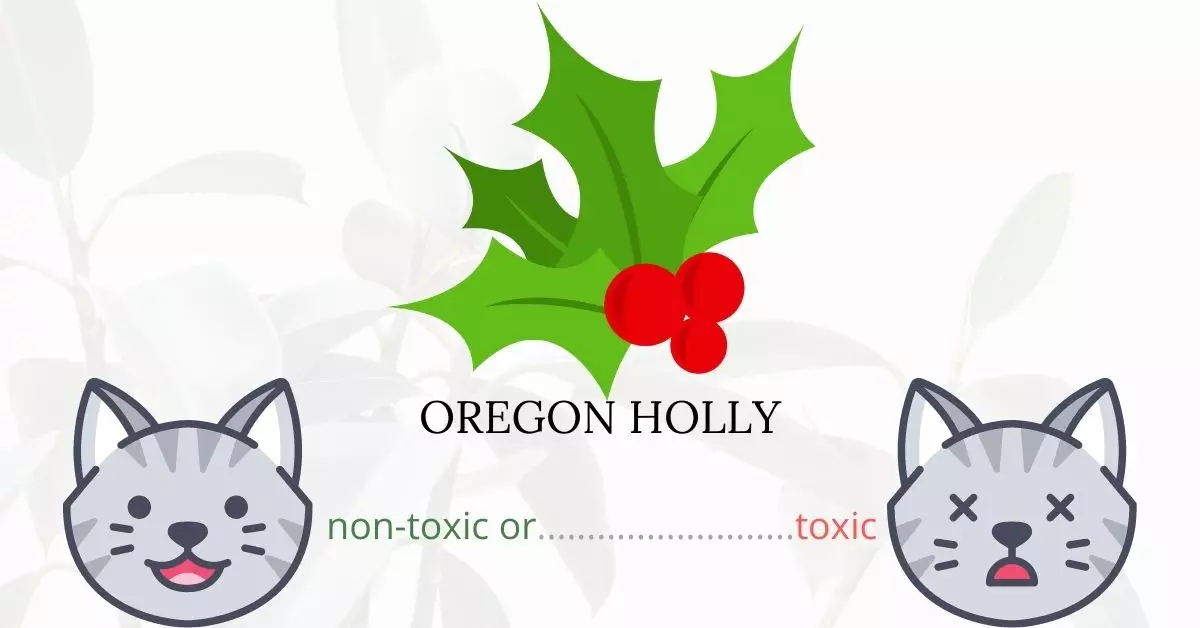Oregon holly, commonly known as English holly, European holly, American holly, and winterberry, is indeed toxic to cats. The primary toxins are saponins, which are irritants that can adversely affect a cat’s oral cavity, gastrointestinal tract, and skin. Although Oregon holly poisoning is seldom life-threatening, it can result in significant discomfort for cats that have been exposed to or have ingested the plant. It’s essential to note that saponin glycosides are most prevalent in the young leaves and berries of the Oregon holly plant, leading to potential red blood cell damage and alterations in the small intestinal mucosal cells.
This article is a result of collaborative efforts with a team of experienced DVMs (doctors of veterinary medicine). Through their valuable input, we aim to provide accurate and up-to-date information about the potential risks posed by various plants, specifically Oregon Holly, to cats. Additionally, our research extends to high-authority websites, such as ASPCA and PetMD, to ensure a comprehensive understanding of every plant we discuss.
Clinical Signs of Oregon Holly Poisoning in Cats
Cats exposed to Oregon Holly through ingestion or contact can exhibit a range of clinical symptoms due to the presence of saponins, compounds known to cause irritation and alter normal bodily functions. Understanding each sign can help in early identification and management of the toxicity. Here are the clinical signs broken down with explanations:
- Excessive Drooling: This occurs because saponins irritate the oral cavity. As a defensive mechanism, the body produces excessive saliva to flush out the irritant. This increased salivation is noticeable and often immediate after exposure.
- Vomiting: Once ingested, saponins act as gastrointestinal irritants. The body responds by trying to expel the harmful substances through vomiting. This is usually one of the early signs of Oregon Holly poisoning.
- Diarrhea: The irritative properties of saponins extend to the intestines, disrupting normal digestive processes and leading to diarrhea. This can result in dehydration if not addressed promptly.
- Depression: The discomfort and malaise caused by the saponin’s effects can make cats appear lethargic or depressed. This sign is reflective of the systemic impact of the toxins present in Oregon Holly.
- Pain in the Abdomen: The irritation to the gastrointestinal tract induces abdominal pain, causing cats to express discomfort through vocalization, altered posture, or withdrawal from contact.
- Increased Heart Rate and Respiratory Rate: These occur as physiological responses to the distress and pain caused by the toxin. The body responds to discomfort and pain with an increased heart and respiratory rate, reflecting the cat’s stressed state.
Understanding each of these signs provides insight into the immediate and uncomfortable effects saponins from the Oregon Holly plant can have on cats. Immediate intervention and veterinary consultation are crucial when these signs are observed, to mitigate the effects of the poisoning and to ensure the well-being of the affected cat.
First Aid and Treatment of Oregon Holly Poisoning in Cats
The first step in the treatment will be to remove any remaining Oregon holly from the cat’s stomach. Depending on your cat’s condition, the vet may induce vomiting, provide activated charcoal, or perform gastric lavage or a stomach pump.
In order to preserve the stomach lining and prevent the recurrence of symptoms, the veterinarian may prescribe drugs. In case of skin irritation, the vet may administer a corticosteroid to reduce inflammation and irritation.
Because of the forced vomiting, the cat may get dehydrated during treatment. If this happens, the veterinarian will give your cat intravenous fluids to keep her healthy.
Recovery from Oregon Holly Poisoning in Cats
Because Oregon holly poisoning is rarely lethal, a cat should be able to recover completely without further issues. The vet may advise feeding softer meals to keep the cat’s stomach from becoming inflamed. In the days following therapy, keep the cat calm and comfortable to help him restore his strength.
Prevention of Oregon Holly Poisoning in Cats
Staying indoors is the best method for cats to reduce the risk of exposure to toxic plants outside. Keep them mentally stimulated indoors by utilizing cat trees, playpens, and other toys suitable for them. Remove any Oregon holly that may be growing within your yards.
If you love plants but have cats at home, check out these lists:





